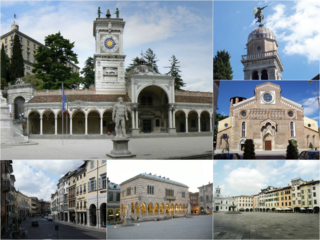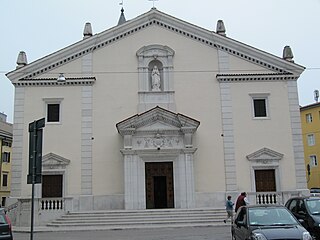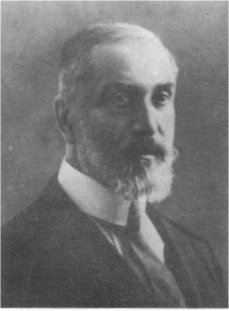
Udine is a city and comune (municipality) in north-eastern Italy, in the middle of the Friuli Venezia Giulia region, between the Adriatic Sea and the Carnic Alps. It is the capital of the Regional decentralization entity of Udine. Its population was 100,514 in 2012, 176,000 with the urban area.

Friuli-Venezia Giulia is one of the 20 regions of Italy and one of five autonomous regions with special statute. The regional capital is Trieste on the Gulf of Trieste, a bay of the Adriatic Sea.

Friuli is a historical region of Northeast Italy. The region is marked by its separate regional and ethnic identity predominantly tied to the Friulians who traditionally spoke the Friulian language. It comprises the major part of the autonomous region Friuli Venezia Giulia, i.e. the administrative provinces of Udine, Pordenone, and Gorizia, excluding Trieste.

The Province of Udine was a province in the autonomous region Friuli-Venezia Giulia of Italy, bordering Austria and Slovenia, with the capital in the city of Udine. Abolished on 30 September 2017, it was reestablished in 2019 as the Regional decentralization entity of Udine, and was reactivated on 1 July 2020. It has a population of 530,849 inhabitants over an area of 4,907.24 square kilometres (1,894.70 sq mi).

Tarvisio is a comune (municipality) in the Regional decentralization entity of Udine, in the autonomous Friuli Venezia Giulia region of Italy.

The Archdiocese of Gorizia (Latin: Archidioecesis Goritiensis is a Latin archdiocese of the Catholic Church in Italy. The archiepiscopal see of Gorizia was founded in 1751 when the Patriarchate of Aquileia was abolished, and its territory divided between two new dioceses, Udine and Gorizia. The diocese of Gorizia was suppressed in 1788 for the creation of the Diocese of Gradisca and re-established in 1791 as the Diocese of Gorizia e Gradisca. It was raised again to a metropolitan archdiocese in 1830.

The Princely County of Gorizia and Gradisca, historically sometimes shortened to and spelled "Goritz", was a crown land of the Habsburg dynasty within the Austrian Littoral on the Adriatic Sea, in what is now a multilingual border area of Italy and Slovenia. It was named for its two major urban centers, Gorizia and Gradisca d'Isonzo.

The Operational Zone of the Adriatic Littoral was a Nazi German district on the northern Adriatic coast created during World War II in 1943. It was formed out of territories that were previously under Fascist Italian control until its takeover by Germany. It included parts of present-day Italian, Slovenian, and Croatian territories. The area was administered as territory attached, but not incorporated, to the Reichsgau of Carinthia. The capital of the zone was the city of Trieste.

The Armistice of Villa Giusti or Padua Armistice was armistice convention with Austria-Hungary which de facto ended warfare between Allies and Associated Powers and Austria-Hungary during World War I. Allies and Associated Powers were represented by Italy. The armistice protocol together with supplementary protocol was signed on 3 November 1918 in the Villa Giusti, outside Padua in the Veneto, Northern Italy, and took effect 24 hours later. This armistice applied only on Austria because Hungary later signed separate Belgrade armistice.

Malborghetto Valbruna is a comune (municipality) in the Regional decentralization entity of Udine in Friuli-Venezia Giulia, north-east Italy.

Paluzza is a comune (municipality) in the Regional decentralization entity of Udine in the Italian region of Friuli-Venezia Giulia.

Paularo is a comune (municipality) in the Regional decentralization entity of Udine in the Italian region of Friuli-Venezia Giulia, located about 110 kilometres (68 mi) northwest of Trieste and about 50 kilometres (31 mi) north of Udine, on the border with Austria.

Pozzuolo del Friuli is a comune (municipality) in the Regional decentralization entity of Udine in the Italian region of Friuli-Venezia Giulia, located about 60 kilometres (37 mi) northwest of Trieste and about 10 kilometres (6 mi) southwest of Udine.
San Giorgio di Nogaro is a comune (municipality) in the Regional decentralization entity of Udine in the Italian region of Friuli-Venezia Giulia, located about 50 kilometres northwest of Trieste and about 25 kilometres (16 mi) south of Udine. As of 31 December 2004, it had a population of 7,417 and an area of 25.8 square kilometres (10.0 sq mi).
Sagrado is a comune (municipality) in the Regional decentralization entity of Gorizia in the Italian region of Friuli-Venezia Giulia, located about 35 kilometres (22 mi) northwest of Trieste and about 13 kilometres (8 mi) southwest of Gorizia, on the left bank of the Isonzo River.

The Great War is a 1959 Italian comedy-drama war film directed by Mario Monicelli. It tells the story of an odd couple of army buddies in World War I; the movie, while played on a comedic register, does not hide from the viewer the horrors and grimness of trench warfare. Starring Alberto Sordi and Vittorio Gassman and produced by Dino De Laurentiis, the film won the Golden Lion at the Venice Film Festival. Its crew also included Danilo Donati (costumes) and Mario Garbuglia.

The Alpine Brigade "Julia" is a light infantry brigade of the Italian Army, specializing in mountain warfare. Its core units are Alpini, an infantry corps of the Italian Army, that distinguished itself during World War I and World War II. The brigade carries on the name and traditions of the 3rd Alpine Division "Julia". The division's and brigade's name allude to the Julian Alps in the Friuli region where the division's regiments recruited their troops, and where after World War II the brigade was based. Accordingly, the brigade's coat of arms is modeled after the Friuli region's coat of arms.

Trieste Centrale railway station (Italian: Stazione ferroviaria di Trieste Centrale; German: Triest Südbahnhof is the main station serving the city and municipality of Trieste, in the autonomous region of Friuli-Venezia Giulia, northeastern Italy.
Tarvisio–Udine railway is an Italian railway line that connects Udine and Tarvisio. It is also called the ferrovia Pontebbana in Italian after the town of Pontebba, which was located near the former border between Italy and Austria-Hungary during the first thirty years of its operation.

Roberto Ghiglianovich was a Dalmatian Italian politician.
















